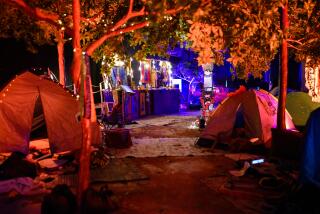Silent witnesses to Sept. 11
- Share via
An unfathomable day is described in the simplest of terms -- a telephone, a squeegee handle, a pair of shoes. They are ordinary items that unexpectedly elicit the “quiet horror” of 9/11 in an exhibition opening today at the Japanese American National Museum.
In all, 45 objects, as well as images and video, are included in “September 11: Bearing Witness to History,” a Smithsonian traveling exhibition from the National Museum of American History.
Each item has its own story to tell.
The telephone delivered Barbara Olson’s voice to her husband, Solicitor General Theodore B. Olson, one final time before her flight crashed into the Pentagon. The metal squeegee handle was used to dig through an elevator shaft, allowing a window washer and five others to flee the north tower of the World Trade Center before its collapse.
And the shoes belonged to Maria Cecilia Benavente.
Benavente removed them to speed her descent down 25 flights of stairs to an express elevator after seeing smoke and flames in the adjacent tower and feeling an explosion of heat. Once outside, she carried them as she fled barefoot, holding hands with colleagues. As she was running, she heard the south tower collapse, many of her friends still inside.
After walking for what seemed hours with a co-worker, they arrived at the co-worker’s parents’ home in Queens. Benavente was unable to reach her sister, who also worked in the city, or her parents in Montreal. She watched television coverage for a while but became overwhelmed. Covered with dust, her feet too swollen to wear the shoes, she walked outside still barefoot.
“I felt so alone,” she says.
Drawn to the garden, she touched the vegetables and the soil and began picking tomatoes without fully realizing what she was doing. Just the simplicity of it, she says, was soothing. Her parents had a garden in Montreal.
In the days after the attacks, Benavente knew she could not stay in New York. She now lives in Chicago, where she lives life differently, volunteering at a soup kitchen and taking nothing for granted. When she sees something about 9/11 on television, she changes the channel.
In a recorded interview that’s part of the exhibition, Beatriz Susana Genoves, a restaurant employee stationed on the 78th floor of the north tower, tells how she escaped down a stairway.
“Later, after I got out of the building, someone said, ‘Run, the building is going to collapse,’ so we crouched behind a car,” Genoves says. “There was a roar like an airplane, and then the white smoke went all over us. I couldn’t breathe. If I opened my mouth, it would fill with dust. I said, ‘Oh my God, I’m dying.’ When I saw myself in the mirror, I was all white. I said, ‘It’s not me.’
“For so many nights, I couldn’t sleep. I would remember the faces of everyone going up the elevator, and I cried. I cried. This is my problem, I remember the people.”
The exhibition, says co-curator Kathleen Kendrick, required a unique approach.
“We chose to be upfront with the public and let them know that this exhibition does not attempt to explain Sept. 11 or to meditate on the consequences of it,” she says.
“It’s really just about documenting that day, bringing out objects and images and personal stories that all bear witness to what happened on that day and to provide an opportunity for people to remember, to reflect and to share their own memories.”
Care has been taken not to include items that might be considered gruesome or overly invasive, says Kendrick. Still, she says, there is near silence as people make their way through the exhibition, a feeling of “quiet horror” unchanged since its opening on the first anniversary of 9/11.
“It’s a remarkable thing to witness the quietness that comes over people,” Kendrick says. “The most compelling items, in a way, are the ordinary objects that have been transformed by their association with the events of that day.”
This is the third stop for the exhibition, which continues through Aug. 15, and its only visit to California.
Because most people witnessed 9/11 in television coverage, the exhibition also includes a video, produced by ABC News, of how the day was experienced on the other side of the anchor’s desk through the words of Peter Jennings.
Visitors will have an opportunity to write how they witnessed the events and how their lives have changed. Comments will be archived and available online.
While the subject matter is not uniquely related to the Japanese American experience, Irene Hirano, president and chief executive officer of the Japanese American National Museum, says the exhibition reflects the balance and range the museum, a Smithsonian affiliate, attempts to create through its programming.
*
‘September 11: Bearing Witness to History’
Where: Japanese American National Museum, 369 E. 1st St., L.A.
When: Opens today; ends Aug. 15. Hours: 10 a.m. to 5 p.m. Tuesdays through Sundays, except Thursdays, until 8 p.m.
Special events: Opening-night concert, “Where Is the Way That Light Dwelt?” by the Los Angeles Master Chorale, conducted by Grant Gershon, 7:30 p.m. Presentations at 12:30 p.m. each Wednesday featuring community leaders, artists, activists and educators.
Price: $8 adults, $5 seniors, $4 students and youth (6-17); free to members and children 5 and younger.
Contact: (213) 625-0414 or www.janm.org. More on the exhibition: www.americanhistory.si.edu/september11/
More to Read
The biggest entertainment stories
Get our big stories about Hollywood, film, television, music, arts, culture and more right in your inbox as soon as they publish.
You may occasionally receive promotional content from the Los Angeles Times.










